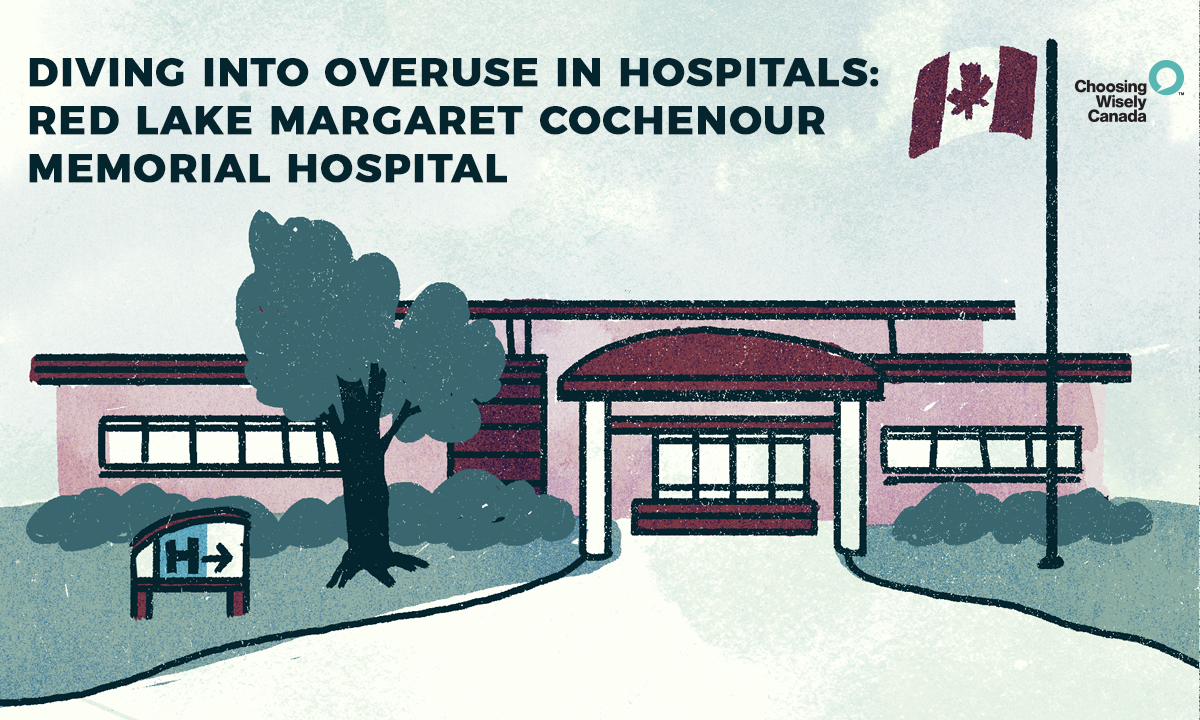Choosing Wisely at Red Lake Margaret Cochenour Memorial Hospital
Feb 11, 2019 - Profiles
See how Red Lake Memorial Hospital is diving into overuse and reducing unnecessary tests and treatments.
Choosing Wisely at Red Lake Margaret Cochenour Memorial Hospital
Feb 11, 2019 - Profiles
See how Red Lake Memorial Hospital is diving into overuse and reducing unnecessary tests and treatments.

Red Lake Margaret Cochenour Memorial (MCM) Hospital is a small community hospital located in the town of Red Lake in Northwestern Ontario. With 14 acute care beds and four chronic care beds this remote hospital is smaller than most wards in a city hospital. It is staffed primarily by nurses and shares physicians with other hospital associated clinics. There are seven physicians in total who practice at the hospital, four full time and three other physicians consisting of rotating locums. Despite the hospital’s small size it is still accountable, as all hospitals are in Ontario, to submit a Quality Improvement Plan (QIP) to Health Quality Ontario (HQO) outlining how they will improve the quality of the care delivered annually through focused targets and actions.
The hospital’s Director of Risk Management and Patient Relations Amanda Kaczmarek, along with the Chief Nursing Officer, Rebecca Ross, and Manager of Laboratory Services, Jennifer Sanna-White, presented a list of possible priority Choosing Wisely recommendations to the Red Lake MCM’s Medical Advisory Committee (MAC) in 2017. They specifically highlighted the opportunity to including physician-aimed goals and measures relating to Choosing Wisely on the QIP. Amanda recalls, “What we usually saw with our QIP is that physicians were aware of what we were working on but maybe we didn’t always engage them. Incorporating Choosing Wisely was an opportunity to involve them in something we knew was meaningful to them.” In addition, Red Lake MCM had just hired a sizable number of new nursing staff – making Choosing Wisely a part of their QIP offered an opportunity to reinforce best practices for senior staff and created an evidence based standard of care across the hospital going forward.
A brief list of high priority suggestions were offered to Red Lake MCM’s MAC from the hundreds of Choosing Wisely Canada recommendations. There were two areas of focus the physicians were particularly receptive to and that aligned with local efforts. These were reducing unnecessary use of diagnostic imaging for ankle and foot injuries in the emergency department by way of the Ottawa Ankle Rule (OAR) and reducing unnecessary blood transfusions.
Imaging of the ankle and/or foot for patients who are negative for the OAR does not improve outcomes, exposes the patient to unnecessary ionizing radiation and contributes to flow delays in the emergency department without providing additional value. Rebecca explained, “The hospital has no physician or diagnostic imaging support at night and nurses’ are responsible for first assessment and triage across the hospital’s wards. Physicians rely on nurses’ assessments for next steps.” implementing a tool that positively affected patient wait times and staff resources was quickly adopted.
Changing hospital and lab culture around implementing single unit transfusions, on the other hand was not as straightforward. Luckily, the hospital had the Kenora Rainy River Regional Lab Program (KRRRLP), a group that offers administrative and technical advice, consultative, educational and quality support services to six Northwestern Ontario labs as well as provides quality assurance assistance. The KRRRLP was introducing a program to all sites, including Red Lake MCM, now asking physicians to only transfuse a single unit of red blood cells for stable non-bleeding patients. “In the past we would audit single unit transfusions for the opposite reasons” said Jennifer.
Measures were put in place and laboratory technicians would intervene at the point of ordering. If two units of blood were ordered without indication, the physician would be contacted and the new process as well as evidence supporting it was discussed. Jennifer reflects, “Single unit transfusions tend to be more complicated in a small hospital like ours because we don’t have an OR. We found after auditing and reporting on our transfusions for one year that the majority of our transfusions were appropriate.”
Amanda adds, “Although we did not discover much inappropriate use and therefore were not able to decrease our utilization by any sizable amount it reinforced to us that we were using the limited resources we have wisely.” Since meeting their 2016-17 QIP goal, Choosing Wisely Canada has become a resource Red Lake MCM refers to when considering changing hospital practices.
Red Lake MCM is in the midst of planning a regional antimicrobial stewardship initiative with Kenora Rainy River Regional Laboratory Program partners. Red Lake MCM and their partners are looking to Choosing Wisely Canada recommendations for ongoing inspiration on opportunities to reduce overuse and avoid wasting precious health care resources.
